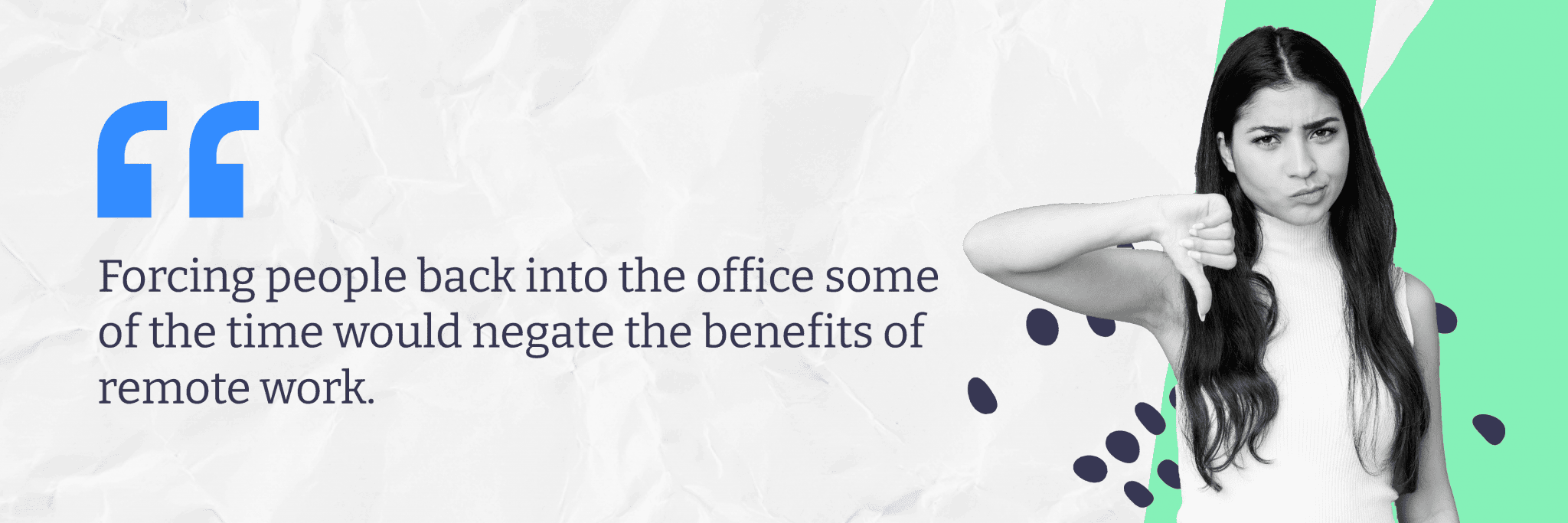There Are Only Two Approaches to Hybrid Work, and One Is Clearly Better

Barry Nyhan
Senior Demand Gen & Marketing Ops
July 19 2022

When weighing up approaches to hybrid work, ‘radical flexibility’ is better for business – but how feasible is it?
As flexible work becomes more a function of policy than health and safety necessity, two different approaches to hybrid work are emerging – one of which is significantly better than the other.
Not all that long ago, when most workers were still in lockdown and hybrid work was still a post-pandemic pipe dream, many observers (myself included) made some pretty lofty predictions about how things would shake out. While some took a more optimistic view of hybrid work’s potential, others fixated on some very real impending challenges. Now it appears both camps were right.
The first broad and wide-reaching prediction that was levied (by the fine folks at The Economist, The New York Times and Wired, to name a few) was that hybrid work would offer the worst of both worlds.
The theory suggested that forcing people back into the office some of the time would negate the benefits of remote work – like being able to move further away from the office – and those of in-person work – like having greater work-life separation. It would also do little to solve the biggest challenges of each arrangement. Hybrid workers, they feared, would still be subjected to proximity bias, feel less connected to their colleagues, and would become resentful if forced to commute to the office just to spend their day in virtual meetings.

The other big and bold prediction about remote work, made during a period in which it was still more theoretical, was that there would be a wide range of hybrid models to choose from. This theory (which was put forward by Inc. Magazine, The Harvard Business Review, and BCG, to name a few) suggested that organizations would have to select their ideal position along a spectrum that ranged from fully remote to fully in office.
While parts of both of these predictions have come to fruition there is now sufficient data to suggest that most organizations are pursuing one of only two hybrid work models. And, as many had feared, one of them does indeed offer the worst of both worlds – or at least many of the worst aspects of both fully in-person and fully remote working arrangements.
With two approaches to hybrid work, try to take the one less traveled…
Those two models, which were more thoroughly researched and defined by Gartner, include the more basic (and frankly, lazy) approach to hybrid work – where organizations designate specific days when their staff can choose to work from home – and what Gartner calls “radical flexibility”, which gives employees some or full control over when and where they work each day.
According to Gartner, when employees are given some degree of choice in where and when they work 55% achieve “high performer” status, compared with just 36% of those who work in an office full time.
As Brian Kropp, the chief of research for Gartner’s HR practice told me in an interview for a story I recently published in Fast Company, not all organizations are prepared for a world of radical flexibility. Providing that degree of employee autonomy without descending into total chaos requires adopting new tools, new strategies, and an entirely new approach to people management. While some organizations are well equipped to make the transition to a radically flexible hybrid work structure, many aren’t.
The large proportion that isn’t prepared for a world of radical flexibility is instead opting for the more rigid approach to hybrid work as a sort of concession to employees who are demanding more remote opportunities. Kropp explained that just about any organization could adopt new tools and technologies to give workers more autonomy over their work arrangement, but not every organization employs managers that are capable of leading a radically flexible team.

“If you’ve got a managerial population that doesn’t have a lot of sophistication and maturity, and you put them in a world of radical flexibility, it’s going to be a train wreck,” he said.
Kropp and his team estimated that about one-third of managers are prepared to manage a hybrid team with radical flexibility, and another quarter or so can be trained to manage a radically flexible team over time. The rest, unfortunately, will never be able to relinquish that much control to their staff.
As a result, organizations need to choose their hybrid approach very carefully. Those who have the systems, tools, and staff to go the route of radical flexibility have the opportunity to enjoy the benefits of both in-person and remote work. Those who are offering a hybrid structure that doesn’t provide employees with greater choice in terms of when and where they work, however, might end up with a hybrid work strategy that indeed combines the worst of both in-person and remote work.
In a way, those early predictions did prove true. While there are a wide variety of hybrid work models, most lean in one of two directions: either towards giving employees significant control over where and when they work, or keeping the decision power at the organizational level. While the former is demonstrably better for both individuals and the business as a whole, many organizations are simply not in a position to adopt it.